Physical problems during or after pregnancy
Experiencing physical discomfort during (and also after) pregnancy, is often inevitable. The bodies hormonal and physical situation change continously and sometimes the body has unsufficient time to adjust to these. Mostly the problems dissapear again and needs the body just a bit extra time to adapt to the changes. This is not always the case unfortunately. In these cases it is useful to visit a physiotherapist that is specialised in pregnancy related problems.

Most of the problems during and after pregnancy, will be found in the pelvic area. ‘Pelvic girdle pain’ can be very problematic. Because the pelvis has to bear the weight of the unborn child and because it is so centrally located in the body, it can lead to a lot of disability in functioning and activities.
During pregnancy, labor and the period after that, the pelvis gets to endure a lot of extra load and stress. Pregnancy related pelvic pain occurs in as much as between 39% and 80% of women according to scientific research.
The physical and hormonal changes during pregnancy often lead to imbalances that are so strong, that they result in a lot of pain and strong disabilities in daily life activities. After childbirth there is hardly any to no time to recover and the new forms of load and rhythms around taking care of the newborn baby (that increases in weight quickly), also demand a lot of body and mind.
Although many mothers experience having the opportunity to bring a child into this world as a magical process, almost every (upcoming) mother also notices how big of an impact it has physically as well as mentally. Where the mom is the only one who can carry the unborn baby, fortunately she isn’t alone when it comes to pregnancy related problems and can count on the support of a specialised physiotherapist.
Physiotherapy during and after pregnancy
The physiotherapist focuses on all problems that are influenced by posture and movement and interfere with functioning. Through treatment, exercises, advice and reassurance, a lot of problems can be reduced. Also during and after pregnancy.
To get a more precise indication for whether your problems are an indication for physiotherapeutic treatment, the OCI table is a useful tool. Take every activity mentioned and look for the answer that most matches your situation.
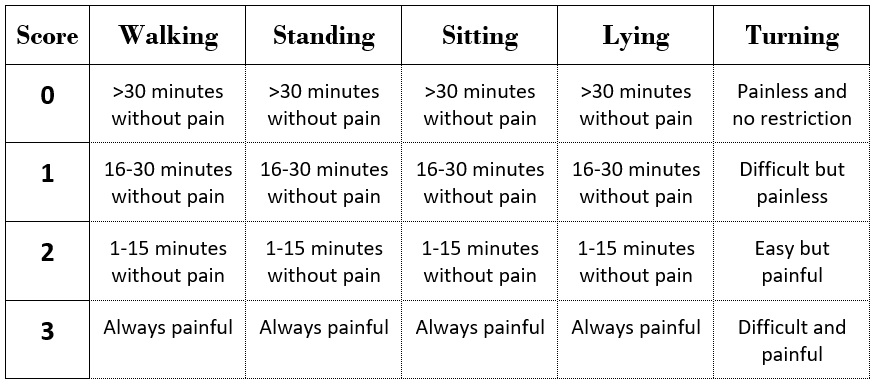
Now add up the scores of these five activities.
When your total is more than four, it is advised to consult a physiotherapist.
The treatment of pelvic pain during pregnancy is mostly aimed at keeping the joints in and around the pelvis free and flexible, increasing the stability in the pelvic girdle and the releasing of too much tension in the area. This is done by physical treatment, exercises and specific advice. Also there is attention for relaxation and for connecting with the pelvic area and unborn baby. We collaborate closely with verloskundigenpraktijk Vondelpark and therefore the lines for consultation with the midwives are short.
After the pregnancy the support is mainly aimed at optimising the conditions for healing and recovery in the areas of mobility, strength, stability but also relaxation. All to be able to function normally again as quick as possible but in a responsible way. Also here physical treatment, exercises and advice are used.
A specialised and holistic approach
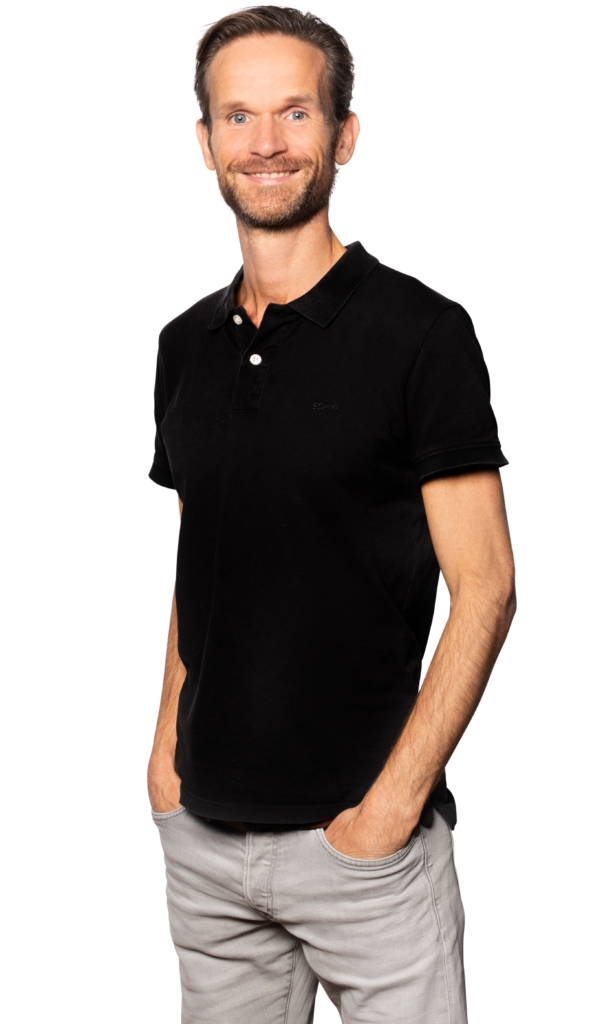
In treatments there is always focus on the bigger perspective of things. Childbirth is more than just a physical process, there is also a strong emotional and spiritual context and above all it is a very natural process. Pregnancy, childbirth and parenthood is kind of the opposite of school. You don’t get the lessons first and then the exam, it is the other way around. Some guidance can be very welcome. There are many great courses for that (I like to refer to the ones of Sarah and colleagues) and specialised therapists. For all your physical problems during and after pregnancy, a desire for more relaxation or more holistic support, you are more than welcome with me.
As a physio and manual therapist I have years of work experience and specialist knowledge in the domain of pelvic problems. From a large part of the country people visit me for problems with the tailbone, I completed the course ‘Pelvic pain during and after Pregnancy’ at Rost Therapy and see the pelvis as more than just a mechanical area. It is the area of your home base and safety and of your power of creation, creativity and gut feeling.
Next to my ongoing trainings within the area of physiotherapy, I am a certified breath coach and meditation trainer and like to use my experience to support the therapy from these areas as well. Both breathwork and meditation help to establish more connection with the body, especially pelvic region and you natural inner wisdom. This doesn’t only help during labor and recovery, it can also have an important stabilising and calming effect (around the pelvis and in general) whenever needed and it can help you during and around labor to find and restore the balance. Specific breathing exercises can thereby help to improve the freedom of movement in the pelvic area and especially the diaphragm. This often forgotten muscle is one of the most important in the body and has an essential function for breathing, the heart and other surrounding internal organs and also being able to have an optimal way of giving birth. A nice and rhythmic movement of the diaphragm can give the unborn child a nice and comfortable massage. The probably most profound effect of breathwork and meditation is that after and already during pregnancy, it can deepen the connection with the child. These are extremely valuable additional tools that I can add, if desired, to my treatments as a physio.
As you can read at the page about me as a physiotherapist, I approach physical problems from a broad and holistic perspective. The basis is always natures and the bodies natural wisdom and the almost infinite self-healing capacity of our system. In my view, the body does the healing and not the doctor or therapist. We are here to assist the system there where it is not able to connect to it or to resolve things that interfere with healing. The body then does the rest and most complicated part of the process.
You are more than welcome for an appointment
If you like to book an appoitment with me, the door is always open for you. I work at a physiotherapy practice in Amsterdam Zuid, just below the Vondelpark. The Practice fror physiotherapy and manual therapy is situated within the healthcenter at the Dufaystraat 19.
More about me as a physiotherapist, as well as info about the insurance companies where we don’t have a contract with (so there will be a part of the treatment for own costs), you can find at this page.
Do you have any questions or like to book an appointment, feel free to email me at roel@roelwilbers.nl.
Last but not least, some tips and tools for pelvic problems:
Legs apart during postures and activities
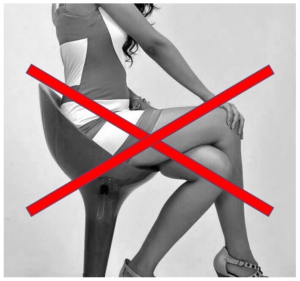
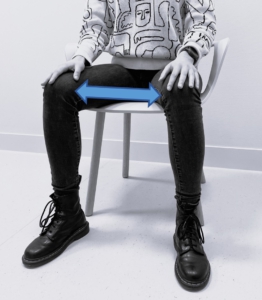
“Wide legged’ is maybe not what society refers to as feminin, it is very effective though with pelvic problems because how the forces are spread and mainly the stability in the pelvic joints is most optimal when the knees are apart. This means that there is less force on the ligaments and that the muscles can do the required task instead of using a lot of power to stabilize the pelvic joints.
So make sure that there is sufficient distance between the knees during all postures and activities where that is possible. Think of sitting, bending over, getting up from a chair and standing. And especially when in pain!
Keep moving

When there are physical problems of any kind, the body and especially the mind instinctively is looking for rest and not for moving. With acute problems and pain that is also the most sensible thing to do, when the problems persist this often has an opposite effect. The body is made for movement and recovers generally quickest under controlled movement. It also prevents muscle tension and joint stiffness and all that this results in.
Wanting to avoid movement is something that occurs a lot in women with pelvic pain. This desire often isn’t driven by the natural physical urges, but by mentally driven fear for pain. This fear of movement often leads to compensatory and forced movement patterns, which results in disturbed motor skills, stiffnesses and weaknesses. This leads inevitably to more pain and this way people end up in a vicious circle. The only way out is often more movement.
This can already be achieved by activities with movement like cycling (on a home trainer if that feels more safe) or walking (in a not to slow pace, bigger steps often works best). Also simple exercises can help like lifting the pelvis lying in the back with the feet flat on the floor, or small squats. Symmetrical movements where the muscles are activated (so not so much yin yoga exercises), are herefore often most effective.
Starting to move more can be a bit scary or painful in the beginning. Remember though that movement is the language of the body and it can often help to breaking the vicious circle and that often it feels freer and better quickly again.
If it is a big step and you would like to have some more guidance and advice, feel free to contact me for an appointment.
Find your center
One of the most important stabilising and core-stability exercises, is finding your center while standing.
First stand tall by raising your chestbone a bit towards the ceiling. Then make sure that your feet are positioned right below the hips (the space between the feet is about the width of a fist) or a bit wider. The feet point forward or are a bit externally rotated, whatever feel most comfortable for you. Check if your knees are ‘unlocked’, that there is a bit more of extension possible. Then focus on your bodyweight resting on your feet and feel that you are really standing and resting on your legs.
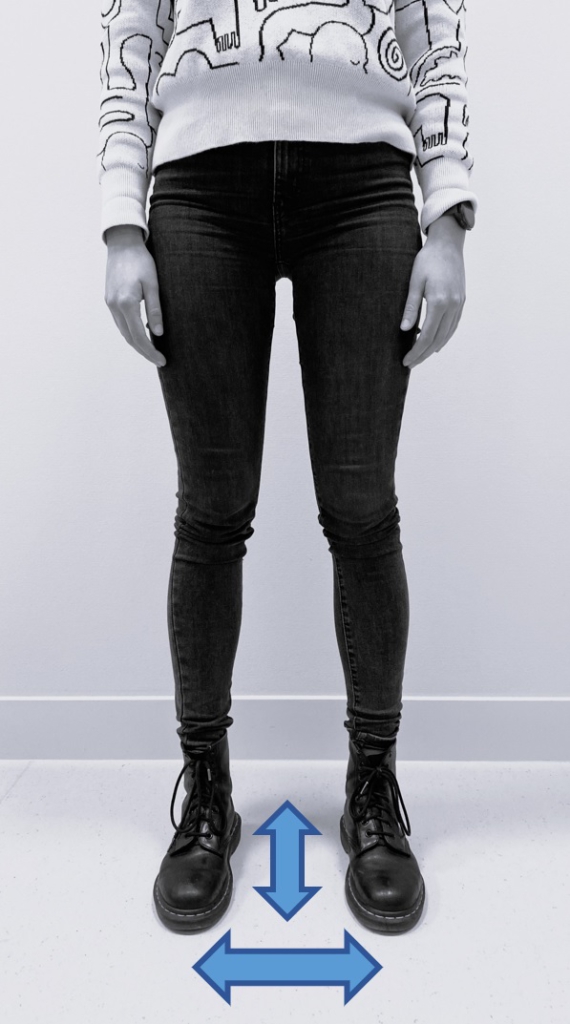
Now feel whether the body weight is equally divided over both feet. Then move ‘mindfully’ calm and controlled from one leg to the other and feel how the weight bearing changes and moves from one foot to the other. Continue by making this sideward movement smaller and smaller until you end up right in the middle and both feet carry an equal amount of your bodyweight. The center of your body is now exactly between both feet.
After that notice how the weight is divided at the sole of the foot and if it is equally divided between the front of the foot and the heel. Now again move ‘mindful’, slowly and controlled a bit forward and backward with your body and feel that the weight bearing is changing from the front of the foot to the heel and back. Continue to make this movement smaller and smaller, until the pressure is exactly equally divided over the front of the foot and the heel. Check if your knees are still unlocked. If you arrived at the correct spot, you are still able to move your toes.
This centered position often directly reduces the pain in the pelvis. An extra support can be given by grounding yourself. Imagining that from your pelvis on, there are two branches growing down through your legs making their way into the earth below and like roots form a firm anchor.
You can repeat this exercise over and over again and this is, as mentioned, a great core-stability training because it addresses the muscle coordination. Move yourself out of the position and back towards it over and over again to get familiair with your center. This is very useful for women who experience problems in the pelvic or general stability, especially during pregnancy when the weight center of the body is constantly changing a bit because of the increased belly weight. This simple exercise can be done almost everywhere and unnoticed, like during standing in line at the supermarket or waiting at the bus stop, school or daycare.
Relax your glutes

The muscles deep in your buttocks often tense up when there is pain, reduced stability or too much tension in the pelvic area. Stretching these muscles can often lead to a quick relief.
Sit down and put the outside of your ankle of the painful or tense buttock, on the knee of the other. Your legs form the so called ‘4-sign’. Grab your knee and pull this gently towards your shoulder on the opposite side of your body. Pay attention that you don’t move your shoulder towards your knee. Make sure your spine is straight and you sit upright.
You will now feel stretch in your deep buttock muscles. Keep it there for ten seconds, or a bit longer if that feels good for you. Often the tension and pain will fade away during the stretch. By playing around with the direction in which you pull the knee, you can adjust the stretch even better towards where you feel you need it.
An alternative is in lying on your back with one foot flat on the floor and the ankle of the other leg on top of the knee again. Now the tension can be applied through pulling over the knee, but also by putting your hands underneath the other knee and bringing the leg up towards your chest. Other alternatives are the so called ‘pigeon pose’ or ‘happy baby’ poses that are often used in yoga.
Find calm and peace by belly breathing
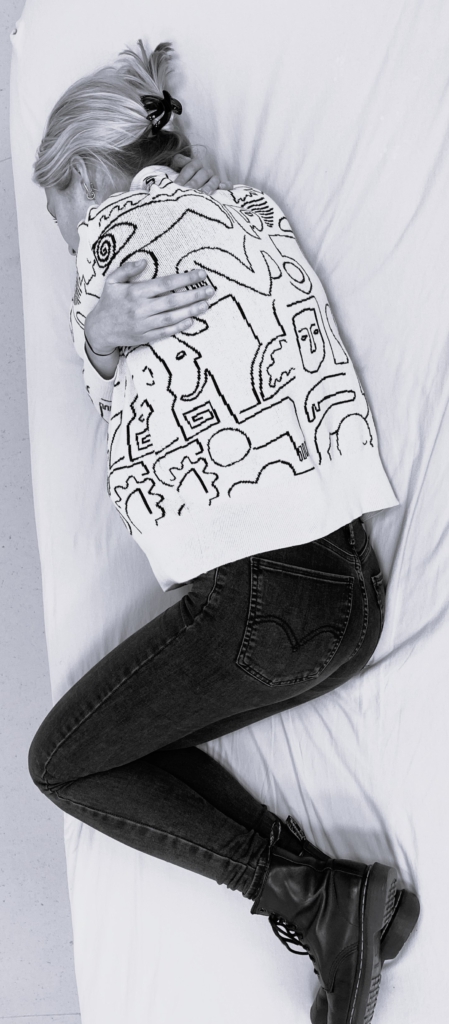
When you feel restless or stressed, the breathing automatically moves upwards towards the chest. When you breath low towards your belly, that is a sign that your system feels safe and with that breathing pattern it is almost impossible to be of stay tensed or stressed. ‘Belly breathing’ is also activation of the diaphragm, a muscle that is very important for breathing freely, the stability of the lower back and pelvis and pushing during labor.
There is a very simple way to realise a belly breath. Lie down on preferably your right side with your knees pulled up and on top of each other. If this is uncomfortable, place a pillow in between the knees and/or find a softer surface to lie down on.
Now bring your left hand underneath your neck and let the tips of the fingers rest on the backside of the vertebrae in your neck. Your thumb is resting next to your fingers. The right arm is brought towards your left armpit and goes underneath your left arm. It rests here on the armpit or area of the shoulder blade. Place your elbows close to your chest and make sure they rest on the floor and now fully relax your bodyweight into the surface below.
In this pose, in which you kind of hug yourself, you will notice that it is almost impossible to breathe ant way other then towards your belly. It is an exercise that quickly brings relaxation in your system. Also it can connect you with the safe basis inside yourself and with your unborn child when you are pregnant. Next to this being a pleasant massage for the baby and belly, you can also use the breathing as a form of transmission to ‘feed’ your baby with attention/energy/love/light/good vibes, whatever works for you. Also when you aren’t pregnant you can do this towards the safe area of your pelvis of course.
By positioning yourself like this in the evening, you’ll probably also have less trouble to relax and fall asleep. Use it also during the day though at every moment you desire a bit more peace and relaxation.
Do you want more breathing exercises for during pregnancy, childbirth or after?
Through the buttom below you will find all the info about breathing during pregnancy and for pregnancy related problems:
